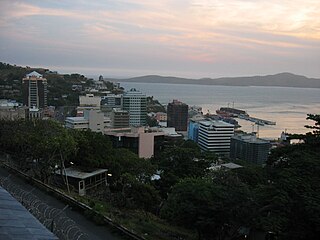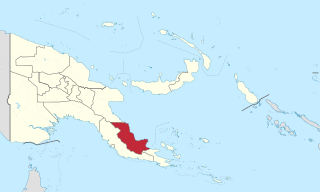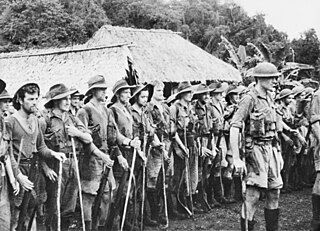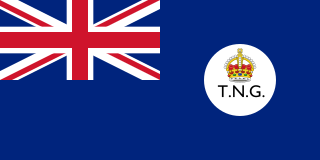This article needs additional citations for verification .(September 2012) (Learn how and when to remove this template message) |
| Boridi | |
|---|---|
| Coordinates: 9°05′15″S147°38′16″E / 9.0874°S 147.6378°E | |
| Country | Papua New Guinea |
| Province | Central Province |
| District | Kairuku-Hiri District |
| LLG | Koiari Rural LLG |
| Elevation | 5 m (16 ft) |
| Population (2000) | |
| • Total | 115 |
| Languages | |
| • Main languages | English, Tok Pisin, Koiari |
| • Traditional language | Koiari |
| Time zone | AEST (UTC+10) |
| Location | 67 km (42 mi) NE of Port Moresby |
| Climate | Cfb |
Boridi is a village in the Owen Stanley Range in Central Province, Papua New Guinea. [1]

Owen Stanley Range is the south-eastern part of the central mountain-chain in Papua New Guinea.

Papua New Guinea, officially the Independent State of Papua New Guinea, is an Oceanian country that occupies the eastern half of the island of New Guinea and its offshore islands in Melanesia, a region of the southwestern Pacific Ocean north of Australia. Its capital, located along its southeastern coast, is Port Moresby. The western half of New Guinea forms the Indonesian provinces of Papua and West Papua.
Boridi is a Koiari village; the Koiaris are famous for serving as carriers for the Australian Army during WWII, along the Kokoda Track (Papua New Guineans from Kokoda and to the west were aligned with the Japanese). It is a mountainous area thick with forest.
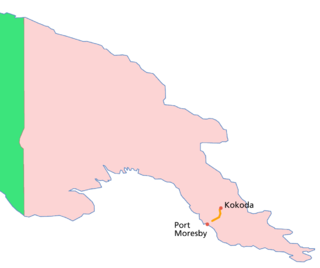
The Kokoda Track or Trail is a single-file foot thoroughfare that runs 96 kilometres (60 mi) overland – 60 kilometres (37 mi) in a straight line – through the Owen Stanley Range in Papua New Guinea. The track was the location of the 1942 World War II battle between Japanese and Allied – primarily Australian – forces in what was then the Australian territory of Papua.
Boridi is a remote village; not being along the Track, it misses out on the development that other track-side villages are experiencing with the increasing number of tourists. The nearest airstrip is in Milei, a 1-hour hike away for locals. There is no aid post (the nearest medical aid would be at Kagi or Efogi). There is a Seventh-day Adventist Church.
Efogi is a town in the Central Province of Papua New Guinea. It is served by air via Efogi Airport.

The Seventh-day Adventist Church is a Protestant Christian denomination which is distinguished by its observance of Saturday, the seventh day of the week in Christian and Jewish calendars, as the Sabbath, and its emphasis on the imminent Second Coming (advent) of Jesus Christ. The denomination grew out of the Millerite movement in the United States during the mid-19th century and it was formally established in 1863. Among its founders was Ellen G. White, whose extensive writings are still held in high regard by the church.
The village is set up around a large quadrangle which serves as a community sports field (soccer and volleyball are very popular); houses line the edge of the field. There are usually several buildings to a household: a kitchen, a building for sleeping, and usually a pitpit/drop toilet. Buildings are made out of bush materials; modern materials have not made their way up here yet, partly because they are expensive and the villagers have limited access to cash; and partly because the mountainous terrain makes it extremely difficult to transport large items.
The main cash crop is coffee. In previous years a coffee buyer from Port Moresby would charter a plane to Millea and locals would load it with bags of coffee beans, which would then be flown to Port Moresby to be sold. However, in 2006 there was no coffee buyer to fund the plane and so locals did not harvest the coffee. Recently rice has been introduced as another crop, but only a small amount is being grown at the moment. The community has a rice mill; what is harvested is used for food, or sold to people in nearby villages (there are no trade stores in the area; the nearest place to buy store goods is Port Moresby, two days and one night's hike away).

Coffee is a brewed drink prepared from roasted coffee beans, the seeds of berries from certain Coffea species. The genus Coffea is native to tropical Africa and Madagascar, the Comoros, Mauritius, and Réunion in the Indian Ocean. Coffee plants are now cultivated in over 70 countries, primarily in the equatorial regions of the Americas, Southeast Asia, Indian subcontinent, and Africa. The two most commonly grown are C. arabica and C. robusta. Once ripe, coffee berries are picked, processed, and dried. Dried coffee seeds are roasted to varying degrees, depending on the desired flavor. Roasted beans are ground and then brewed with near-boiling water to produce the beverage known as coffee.

Port Moresby, also referred to as Pom City or simply Moresby, is the capital and largest city of Papua New Guinea and the largest city in the South Pacific outside of Australia and New Zealand. It is located on the shores of the Gulf of Papua, on the south-western coast of the Papuan Peninsula of the island of New Guinea. The city emerged as a trade centre in the second half of the 19th century. During World War II it was a prime objective for conquest by the Imperial Japanese forces during 1942–43 as a staging point and air base to cut off Australia from Southeast Asia and the Americas.

